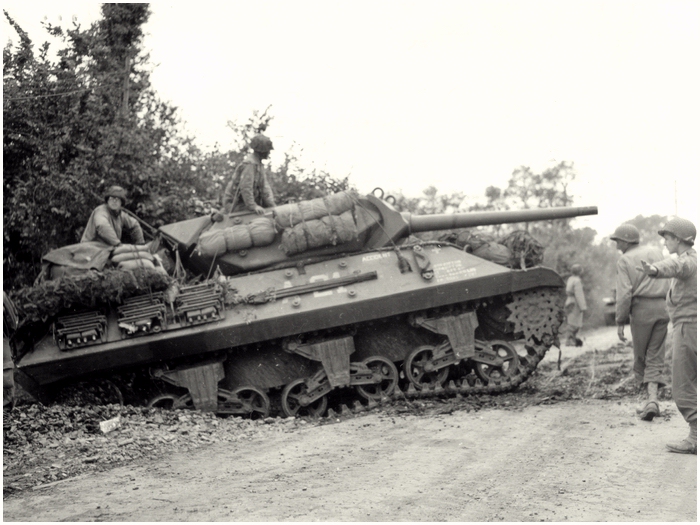
M10, Tank
Destroyer
It was obvious that the gun on the M4 Sherman was not sufficient
against the heavy German tanks. To fill this gap, a M4A2 chassis was used to built a special
purpose vehicle for such a task, a 'Tank Destroyer'. The hull was flattened and the side armor
was placed under an angle to bounce off the hits from enemy tanks. Because of the angular shape,
the armor could be made somewhat thinner to consume on the weight. The first M10 'Tank Destroyer'
rolled out of the factory halfway 1942.

An M10 breaks through the 'bocage'
(the infamous hedges) in Normandy
In the open turret was a 76.2mm M1A1 cannon. This was enough to destroy a Panzer
IV, but the heavy German tanks stayed a tough cookie for the M10. The standard shell in June 1944, the M61
APC, was not strong enough to penetrate a Tiger I in a frontal attack and the Panther could only be stopped
within the 500 meters range of fire . In American service, the M10 was known as the 'Wolverine' or 'Slugger'.
The driver was located, just as in an M4 Sherman, on the port side, but the co-driver position was deleted.
In the open turret was room for the commander, the loader and gunner. A fifth man was used to assist the loader
and the gunner. Additional firepower was from a .50 Browning machinegun on the turret. The six cylinder GM 6064
diesel engine produced 410 hp and gave the M10 a maximum speed of 50 km/h.

M10 with the gun pointed to the right
(so the driver could drive the tank with the hatch open)
This M10 is part of B Company, 703rd TD Bn, 3rd Armored Division
During actions the driver drove the M10 on periscope. The turret and the gun
turned directly over the hatch of the driver. During transfer the turret was turned at 30 degrees to
starboard, so the driver could drive the M10 by sticking his head out of the hatch.

Near Fort Hackenberg
(part of the Maginot Linie), stands this M10
M10A1, Tank
Destroyer
Besides a M10 built on the M4A2 chassis, there was also a version that used the
M4A3 chassis. These version had a Ford GAA petrol engine and were designated as the M10A1.Between September
1942 and December 1943, Grand Blanc Arsenal built 4993 M10's. Ford produced between November 1942 and
September 1943 1038 M10A1's. Besides the M10, Grand Blanc Arsenal produced from September 1943 until December
1943 also 675 M10A1's. A total of 6706 of M10 versions were produced altogether.

At the 'Bastogne Barracks'
stands this 'Achilles'
(ones at Mémorial du Mardasson, Bastogne)
Mk Ic and Mk IIc
'Achilles'
The M10 also saw service in the British army and was known as the MkIc.
In 1944 the British replaced the 76.2mm for the better 17-pounder cannon (the same gun as in the
Sherman Firefly) and was christened with the
name Mk IIc 'Achilles'. From a distant it is obvious to see the difference, the standard M10 had
a smooth barrel, and the 17 pdr. had a muzzle brake with a counter balance below it.
The muzzle brake was developed to blow of gasses so there was less revulsion of the barrel.

The M10
'Achilles' in La Roche, and the muzzle brake with counter weight.

There are still some M10's to find in Europe. In Normandy you can find one
at the Musée Memorial de la Bataille de Normandie in
Bayeux. Another M10 in France is at Fort Hackenberg,
part of the Maginot Line. In the Belgium Ardennes are two M10's, one at the Mémorial du Mardasson near
Bastonge and another one in La Roche-en-Ardenne (both are MkIIc Achilles versions).

The M10 at the Musée Memorial de
la Bataille de Normandie in Bayeux
For the story of the M36 Jackson, you are invited to
CLICK ON THE MkIIc 'ACHILLES' BELOW
|